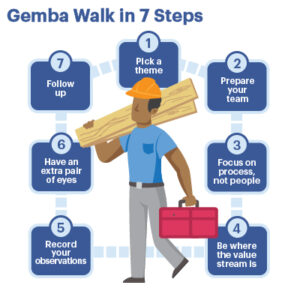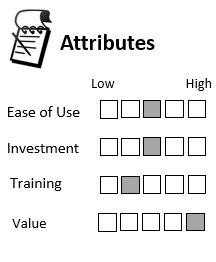Lean experts encourage partaking in Gemba walks (also known as “going to the gemba”) to see how the work is done, allowing for opportunities to identify and eliminate waste.
This usually involves a close physical or personal observation of the work. The Japanese term, Gemba, refers to the location where the work takes place.
Application
A gemba walk is more than just an observation. Gemba walks focus on observation, gaining an understanding of how work is being performed, engaging with workers to understand the what and why for the methods being employed, the challenges being faced, and potential areas where waste is occurring.
This engagement is intended to enable an understanding of the tasks and workplace needs with the direct context of the tasks being performed.

Best Practices
- Use gemba walks to identify wasteful practices.
- Focus on specific parts of your value-creation process and assess it from start to finish.
- Observe and seek to gain understanding while leaving all assumptions at the office.
Process
Gemba walks help the participant understand the process in a more comprehensive way. When you perform a gemba walk, you need to look for any potential area for improvement within an established process of your work.
By recognizing the root cause of the waste in the process (and by applying Lean tools such as 5 Whys or PDCA), you can identify and remove it.
Do
- Prepare a list of questions you are going to ask.
- Focus on the process, not people.
- Explain the purpose of the gemba walk to your team so that they feel more comfortable and are willing to collaborate.
Don’t
- Make suggestions during the walk.
- Forget to share with the team what you have learned or seen (after you have left and analyzed your notes). Inform them about the upcoming changes and why they are necessary.
Business Drivers
- Improve communication
- Streamline problem-solving
- Identify waste in the workplace and processes
- Create cost and time savings
Benefits
- Build stable relationships with those who do the work and create value.
- Identify problems and take actions for achieving continuous improvement.
- Clearly communicate goals and objectives leading to increased employee engagement.

Complementary Methods
- Visual Management
- First Run Studies
- 8 Waste
- Value Stream Mapping
- 5 Whys Analysis
- PDCA
Resources
- Book: How to Do a Gemba Walk: Coaching Gemba Walkers, by Michael Bremer
- LCI Gemba Walk Jobsite Poster